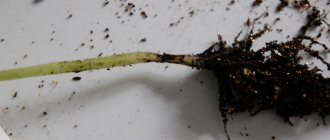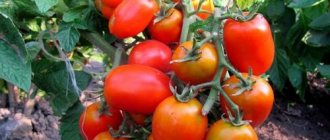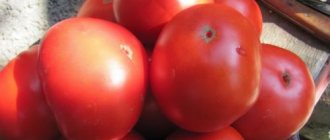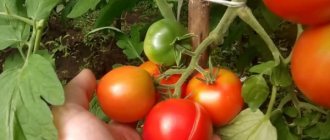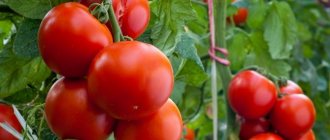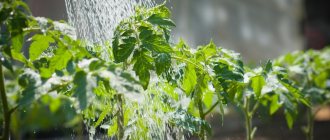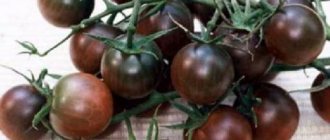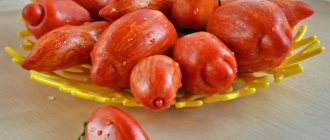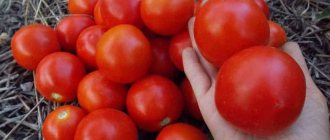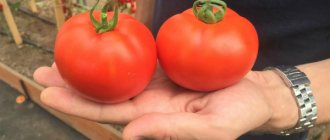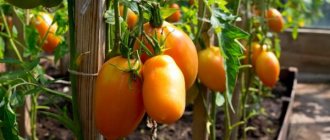Description and characteristics of the variety
The tomato variety French bunch , despite the fact that the name is more reminiscent of a foreign one, was bred in Siberia.
Important! Designed for cultivation in open and closed ground.
- In greenhouse conditions, it can form fruits until frost.
- It has a medium-late ripening period. Ripe fruits can be collected from bushes 120-125 days after seed germination.
- Determinate type of bush, stops growing on its own, reaching a height of 1-1.5 meters.
- Standard. It forms a small number of side shoots, so it does not require pinching.
- To obtain the greatest harvest, it is recommended to form the bush into 1-2 stems, which must be tied to a support or trellis.
- 10-20 fruits are formed on one brush. When grown in central Russia, tomatoes ripen in August.
- Productivity is high. With regular watering and fertilization, 1 bush per season can produce up to 20 kg of tomatoes.
- It is resistant to nightshade diseases, however, preventive measures are required in the form of spraying the bushes with an aqueous solution of antifungal and antiviral biological products. Regular ventilation is necessary in the greenhouse; this will protect the bushes from late blight, gray and white rot.
Important! It is especially important to ventilate the greenhouse after watering to reduce humidity.
Simple tips for planting and care
In February, you need to prepare boxes for seedlings, purchase soil, or bring soil prepared at your summer cottage into a warm room. Seeds hatch faster if the soil is loose, so you should add 1 part peat and 1 part humus to the garden soil.
Water the soil with a solution of phytosporin. This drug kills fungal infection in the soil. After cultivating the soil, tomato seedlings are not threatened with black leg. To guarantee, soak the seeds in a solution of potassium permanganate right on the day of planting. You don't need to hold it for long, 15 minutes is enough.
On the day of sowing, water the soil with warm water, cover the seeds with a 1 cm layer of soil. Cover the boxes with film, place them in a room where the temperature is constant and not lower than 25 ° C.
See also
Description of the tomato variety Peto 86, its characteristics and yieldRead
At the age of 60 days, transplant the seedlings into the ground (greenhouse). Further care will consist of several activities:
- Glaze.
- Weeding.
- Feeding.
- Garters.
- Ventilation.
Tomatoes planted in a greenhouse need ventilation. On sunny days the temperature there is high. Ventilation and watering help reduce soil and air temperatures. A light draft stimulates pollination.
Fruit characteristics
- The shape of the fruit is smooth, oval, slightly elongated.
- The average weight of a tomato is 80-100 g.
- Ripe tomatoes have a bright red color.
- Inside there are 4-6 seed chambers with a small amount of seeds.
- The pulp is fleshy and juicy.
- The taste is sweetish.
- The skin is smooth and dense.
- They have good keeping quality.
- Resistant to long-term transportation.
Advice! The fruits can be picked from the bushes in an unripe state, as they ripen well at room temperature without losing their taste.
Characteristics of tomatoes
Tomatoes of the French grape variety are distinguished by the following characteristics:
- The shape of the tomatoes is very original - they are somewhat elongated in length, slightly reminiscent of fingers with some thickening near the stalk and a prominent nose.
- The fruit has a standard color and is red when fully ripe.
- Tomatoes have a very smooth and dense skin, thanks to which they are not at all susceptible to cracking.
- The size of tomatoes is small, on average their weight is 85-100 grams. On the bush, the fruits grow in large clusters of 8 to 14 pieces each. On average, one bush can have 3-4 similar clusters.
- Naturally, the more shoots left on a tomato bush, the more clusters it can form and ripen with proper care. Hence the secrets of possible high yields. But in this case, caring for the tomato must be very intensive.
- The taste of tomatoes is good, experts rate it a solid four, but due to its thick skin, it is more suitable for pickling rather than salads.
- An ideal pickling variety, because the size is suitable for any jar, even a small one, it does not crack and looks very beautiful when canned whole.
- Tomatoes of the French bunch variety are stored very well and can be stored in a cool place for several months. They also withstand long-term transportation very well, making them suitable for industrial cultivation.
Photo
Below are photos of the French grape variety of tomatoes .
Nuances of crop care
The French bunch tomato needs proper watering and fertilizing. The main thing is to choose the right fertilizers and use them throughout the growing season.
Advice on choosing fertilizers
Fertilizers can be prepared at home and there is absolutely no need to spend money on expensive preparations.
The following fertilizers are used:
- Mullein. Take 500 g of mullein for a ten-liter bucket of water. Stir well and add half a teaspoon of boric acid, 2 tablets of microfertilizers and 1 large spoon of nitrophoska. Water 1 liter for each plant.
- Yeast. For the same volume of water take 10 g of live yeast, 500 g of chicken manure, 500 g of ash and 5 tbsp. Sahara. Leave to infuse for a day. Before use, dilute 1 liter of infusion in 10 liters of water. Apply 2 liters of mixture under each bush.
- Chicken droppings. Add 1 kg of chicken manure to a bucket of water (10 l). Insist for 3 days. Then add 15-16 g of saltpeter. Pour 1 glass of solution under the bush.
See also Description and subtleties of growing tomato Striped chocolate
It is recommended to pre-water the French bunch tomato bushes. Alternate feedings.
Watering rules
Watering is not necessary often. 2-3 times a week is enough. The main thing is that there is enough water for each bush (approximately 2-3 liters for each plant). Use warm and settled water. Do not water using the rain method - liquid should not fall on the leaves and stem. This often leads to the development of rot. It is better to do the work early in the morning or in the evening.
Advantages and disadvantages
French bunch tomatoes have many worthy characteristics, among which are the following:
- high productivity;
- excellent taste;
- ease of care;
- marketable condition;
- long-term storage.
No deficiencies were found in this variety.
- Some gardeners do not like the late ripening period, since when cultivating in open ground they have to pick the fruits in an unripe state and wait until they ripen at home.
Features of agricultural technology
Planting in open ground occurs on the 55-70th day. The exact period depends on weather conditions; the period of sudden frosts should be left behind. Usually, planting is done in a greenhouse in early May, but in open ground - in early June.
Seedlings are placed on the site at the rate of 2 bushes per 1 square meter, so that there is enough space for an adult bush with fruits. As mentioned above, “French Bunch” does not require pinching; the larger the bush, the more harvest it will produce. A garter is required, since the stems often break under the weight of the rich clusters. Therefore, after transplanting into open ground, young plants are immediately tied to trellises or stakes.
Watering
Tomatoes like infrequent but abundant watering, approximately once or twice a week, depending on weather conditions. Well-moistened soil helps them withstand the heat of the day. It is better to water in the evening so that the roots have time to absorb life-giving moisture.
If the plants do not receive the required amount of water, the leaves will begin to darken and wither, so you will immediately understand that you should increase the volume. On average, it is believed that one bush should require about five liters of liquid, and even more during the ovary period.
Of course, it is ideal for plants to be fed by rainwater. As for tap water, it must be left for a certain time to soften, otherwise it negatively affects the acid balance of the soil and harms plants. You can also add weeds or compost to a container of water to help reduce the hardness.
The best watering option for tomatoes is drip or underground. Hose watering can harm the root system of the bush, and getting water on the leaves can cause them to be damaged in the sun or develop late blight spores.
Top dressing
In addition to watering, fertilizing is also necessary from time to time. For “French bunch” it is recommended to do it in three stages:
- During planting, add a solution of nitroammophoska to the wells in a ratio of 1 tbsp. l. powder per 10 liters of water. If possible, pour 4 liters of water into one hole.
- To improve growth. The second feeding is carried out approximately on the 21st day after planting in the ground and includes solutions of potassium nitrate and superphosphate, diluted in accordance with the instructions.
- During the period of flowering and fruit appearance. At this stage, the bushes are fed with mullein infusion, to which 1 tbsp is added. l. urea and superphosphate per 1 liter.
Mulching, weeding, loosening
The purpose of mulching is to maintain normal humidity levels, i.e. mulch retains water, slowing down its evaporation.
Did you know? Tomatoes contain serotonin, the happiness hormone, so they can lift your mood.
In addition, it has a number of additional properties depending on what materials are used:
- Mulching with cut grass. An effective method that nourishes tomatoes with nitrogen and other beneficial substances. To obtain mulch, grass from the lawn and weeds are used, but they must first be dried, otherwise freshly cut grass may rot in the humid environment of tomatoes.
- Mulching with straw. It reflects the sun's rays, prevents bacteria from the soil from contacting the fruits, and also protects the bushes from anthracnose and early rot.
- Mulching with compost. This method is 2 in 1, mulching and fertilizing. Quality compost includes kitchen scraps, last year's weeds and other organic matter.
Important! Bark cannot be used as mulch for tomatoes, since the volatile substances in its composition harm the fruit. Both processes should be carried out extremely carefully, close to the plant, but not deep: otherwise there is a risk of damaging the root system
Both processes should be carried out extremely carefully, close to the plant, but not deep: otherwise there is a risk of damaging the root system.
Features of cultivation
The variety is grown by seedlings; seeds for seedlings are sown in March in the same soil in which the bushes will subsequently grow.
A mixture of garden soil from old humus, taken in equal quantities, is best suited for this.
Important! Before sowing, it is recommended to sift and calcinate the soil.
In order for the seedlings to turn out strong, it is necessary to use the following technology:
- The soil should be light and loose.
- Be sure to create drainage holes in the container to prevent excess moisture from retaining.
- Before sowing, disinfect the seeds in a light solution of potassium permanganate and treat them with the growth stimulator Zircon.
- The seeds are buried 1.5-2 cm into the soil and sprinkled with peat.
- The plantings are watered with warm water using a spray bottle, the containers are covered with film and left in a warm place for germination.
- When sprouts appear, the film is removed and the room temperature is kept within 15 degrees for 7 days. Then the temperature should be about 22 degrees.
- Picking is carried out after the first 1-2 leaves appear on the plants.
- Seedlings are fed several times before planting in a permanent place.
- Seedlings must be illuminated with fluorescent lamps so that they do not grow tall, but become stronger.
- 7-14 days before transplanting, the seedlings are hardened off by taking them outside.
- Seedlings are transplanted into open ground when the soil warms up to 15-17 degrees. Seedlings can be transplanted into the greenhouse 1-2 weeks earlier.
Advice! In central Russia, seedlings can be planted in open ground at the end of May.
If, after planting seedlings in open ground, there is still a risk of night frosts, it is better to cover the plants with covering material.
Important! At an air temperature of +5 °C or less, tomatoes stop growing.
The bushes require a garter as a support or trellis, otherwise they will lie on the ground. This is done on the day of planting the seedlings.
Water the plants at the roots with exceptionally warm water so as not to wet the tops. It is best to organize drip irrigation. You can find out how to do this in the article: How to make drip irrigation in a greenhouse with your own hands...
More information about growing tomatoes is described in the article: Technology of growing tomatoes. Secrets of planting and care
You might be interested in: How to properly plant tomatoes in a greenhouse: bush formation diagram, care features, photos and videos
Useful information: How to properly tie tomatoes in open ground: the best methods, step-by-step photo and video instructions
Growing rules
According to gardeners who have been working with the variety for several years, it is not difficult to grow a rich harvest of tomatoes, provided that agrotechnical standards are followed. This applies to all stages of plant development: from sowing seeds for seedlings to care after planting in a permanent place.
Planting seedlings
Preparing seedlings is an important and crucial moment in growing tomatoes.
You should pay special attention to the following points:
- Soil preparation. Planting seeds can be done either in self-made soil or in a substrate purchased in a store. Before sowing, the containers and soil are treated with boiling water with dissolved potassium permanganate.
- Sowing dates. Seeds are sown early. The main guideline is 2 months before planting seedlings in the ground. Experienced gardeners advise starting work in March if tomatoes will be grown indoors. If in ordinary beds, then in mid-April. In any case, you need to focus on the climatic features of the region.
- Seed preparation. Spores of pathogens may remain on the seeds. Therefore, before sowing, they are soaked in a pale manganese solution for 5-10 minutes. Then washed in clean water. It is advisable to treat the seeds in growth stimulants, for example, in “Ideal”.
- Sowing seeds. Tomato seeds of the French Grozdevoy variety are sown in moist soil to a depth of 1 cm in furrows. It is better to stick to the 1.5x3 cm pattern. Sprinkle warm water on top, cover the container with glass or film and place in a warm place. Seeds germinate well at a temperature of +25 degrees. As soon as the first hooks appear, the coating is removed and the temperature is reduced to 20 degrees.
- Caring for seedlings. Watering should be moderate. At first, the plants are fed with ash.
- Picking. When 2-3 true leaves appear on the seedlings, picking is carried out. This procedure is necessary to build up the root system and provide the plants with a larger nutrient area. The soil is taken the same as when sowing seeds.
- Hardening. 2 weeks before planting, tomatoes begin to adapt to new conditions. First, the seedlings are placed in partial shade for a few minutes, then the stay period is increased.
Tomato transplant
When planting tomatoes, you need to take into account the climatic conditions of the region. If spring is early, then seedlings are placed in protected soil in a permanent place from mid to late May.
As for open ground, planting is carried out after stable warm weather has established, when the danger of a return of frost has passed.
Since the plants are tall and grow greatly in width, then per 1 sq. m it is recommended to plant no more than 2 bushes. They bear a large number of fruits.
Holes are dug at a distance of 50 cm and filled with water. Immediately after planting, the seedlings must be tied to a support. A trellis can be used in a greenhouse. In the future, not only the stem is tied up, but also the inflorescences with fruits.
Subsequent care for tomatoes
Further care, according to gardeners, for the French Grozdeva tomato, does not cause any particular difficulties.
Agrotechnical standards:
- Watering. In tomatoes, the root system develops in width, the plant is able to obtain moisture and nutrients in the required volumes. Plants should not be watered frequently. As a rule, 2 times a week is enough. A bucket of water is poured under each plant. The soil around the bushes needs to be mulched. After each watering, the soil is loosened and weeds are removed.
- Feeding. If the soil was well fertilized before planting, then there is no need to particularly feed the plants. If not, gardeners water the bushes with infusion of mullein, green fermented grass, and ash solution. Of the mineral substances, urea and superphosphate are preferable in the first stages of tomato growth.
- Bush formation. During plant growth, the lower leaves located under the flower clusters are removed. This operation will not only enhance the nutrition of the tomatoes, but will also allow air to circulate freely. This, in turn, will prevent diseases and pests from developing.
Advice! Creating a drip irrigation system will reduce labor costs and the yield will be higher.
To obtain weighty bunches of French Grozdevoy tomatoes, as in the photo, when grown in a greenhouse, you need to follow the following rules:
- avoid high air humidity, ventilate the room frequently;
- to enhance pollination, shake tomatoes in the morning;
- There is no need to allow the plants to become dense.
Growing it yourself
The plant requires obligatory garter
There is nothing complicated in growing seedlings; first we need to sow the seeds in pre-prepared boxes. Description of sowing:
the soil for planting should be fluffed up and fertilized; Place the seeds at a depth of 1.5-2cm and sprinkle with earthen soil: it is important to ensure that the distance between the rows is 3cm; We irrigate the soil with water and cover it with polyethylene to ensure speedy germination.
Having seen the first shoots, you should wait until the sprout produces 2-3 leaves, this is a signal to transplant the seedlings into pots. Be sure to replant the sprouts before they develop large roots, otherwise you risk damaging them and losing some of the plants. Caring for sprouts consists of watering once a day and irrigation with liquid calcium and phosphorus fertilizer. Before planting the plants in the soil, you will need to harden off the seedlings for a week. Place pots of tomatoes outside every day, gradually increasing the time spent outdoors.
Description of preparing the site for planting: flavoring with manure, loosening the soil. After planting, the tomatoes will need daily care: watering, weeding between the rows, applying mineral fertilizers. As the giant tomato grows, it will require garters to supports; you should prepare them in advance or plant some of the sprouts near the fence.
Description of the French grape tomato variety with photo
Despite the “foreign” name, the French grape tomato variety was bred by breeders in Siberia, that is, it is in no way connected with France. While it is not widespread, it is not included in the register of breeding achievements, but some summer residents regularly grow it both in greenhouses and in open beds. The culture can be cultivated in all regions, including those with short summers.
Main characteristics of the variety:
- determinate (the bush grows to a certain height);
- medium-sized (height up to 80-100 cm, less often up to 150-170 cm);
- mid-season (tomatoes are formed in 120-130 days).
The bush is compact, the shoots do not spread out, so the plants do not take up much space. The stems are powerful, the leaves are medium sized, rich dark green in color. The shape resembles a potato leaf, there is no pubescence. The inflorescences are of a simple type, the first of them is formed above the 7, 8 or 9 leaves, the subsequent ones are laid close - through each leaf. Quite a lot of fruits are formed on each flowering cluster - 10-15 pieces.
French bunch tomatoes have time to ripen on the branch
Description of fruits
The photo of French bunch tomatoes shows that the fruits have an interesting pepper-shaped or cylindrical shape, with a slight expansion downwards and a pointed tip (“pipstick”). The surface is glossy, orange-red, without ribbing. Unripe tomatoes are light green, with the color being noticeably darker in the stem area. Tomato size is 8-10 cm (length), average weight is 70-100 g.
The consistency is dense, meaty, the juiciness is not very high, so these tomatoes are not suitable for making juice. The taste is pleasant, with a balance of sour and sweet. The skin is dense but thin, so the fruits are well stored for 3-4 weeks and can be transported over long distances without losing their presentation.
French bunch tomatoes got their name due to the fact that they grow in clusters, 10-15 tomatoes per bunch.
Important! The fruits have 2 nests with seeds. They can be collected for planting next season. The offspring will bear fruit, since the French bunch tomato is a variety and not a hybrid.
Protecting tomatoes from diseases and pests
To prevent the development of infections, the main thing is to follow all the rules for growing crops. In addition, there are several more preventive measures.
Among them:
- Spraying the bushes with such agents as whey, garlic or salt solution. Bordeaux mixture is also used 2 weeks before harvest.
- All garden tools must be disinfected. You can simply pour boiling water on them.
- Do not violate irrigation rules. The French grape tomato does not tolerate drought, but there is no need to over-moisten the soil either.
- To protect against fungus, plants are treated several times during the growing season with a solution of copper sulfate, potassium permanganate or the drug “Fitosporin-M”.
- Seedlings should be planted as far as possible from Solanaceous crops. They are the main source of infection.
- To protect against pests, tomato bushes are sprayed with a soap solution or dandelion infusion.
Expert opinion
Stanislav Pavlovich
Gardener with 17 years of experience and our expert
Ask a Question
Important! It must be remembered that the first protection of the French bunch tomato begins with the proper preparation of planting material.
Characteristics
Such a tasty and beautiful variety was developed through selection by farmers from Siberia. The main feature of the French Grozdevoy tomato variety is the gigantism of the plant itself, in relation to small-sized fruits. Characteristics of the tomato bush:
- super-determinant variety - means that the bush stops growing after the formation of 5-6 ovaries; such tomatoes do not require pinching;
- late ripening – the period of full ripening, from sowing the seed to the formation of the carpal ovary, takes about 150 days;
- the bush is tall - up to 1.5 m, tends to grow in breadth;
- There can be up to 20 fruits on one ovary;
- The yield from 1 bush can be up to 25 kg.
The description of the variety was compiled based on reviews from agricultural workers who have been growing tomatoes for more than 1 year. Tomato fruits reach a weight of 100-150g. They are bright red in color, elongated, oval in shape, slightly pointed towards the bottom.
The soft part of the tomato, according to numerous reviews, has a very refined taste. Its sweetness and juiciness will not leave any vegetable lover indifferent. French tomato skin: dense, smooth. The internal chambers are small in size, there are 3-4 of them.
A qualitative characteristic will tell you about the possibility of the species growing: both in greenhouse conditions and planting seedlings in the soil. The period of fertility in this case will be different, in a greenhouse - until the first frost, and maybe even longer. The same cannot be said about plants growing in open ground; cold weather will stop the fruits from singing.
Positive sides
Among the advantages, the most important is high productivity. This is evidenced by reviews of breeders who are engaged in growing the variety over large areas for sale. Another advantage is the bush’s unpretentiousness: those who have planted this variety at least once are delighted. The attractiveness of the French tomato has an amazing taste and beautiful shape, which is important when selling or packing into jars.
According to numerous reviews, another advantage of tomato is highlighted - it has good shelf life. Thanks to its thick and dense skin, the fruit is good for transporting over long distances. Such fruits can be safely exported to other countries; they tend to ripen, even without sunlight.
Flaws
Disadvantages include long ripening times. Such tomatoes usually ripen in early August, and when growing in open ground, they even have to collect green fruits.
